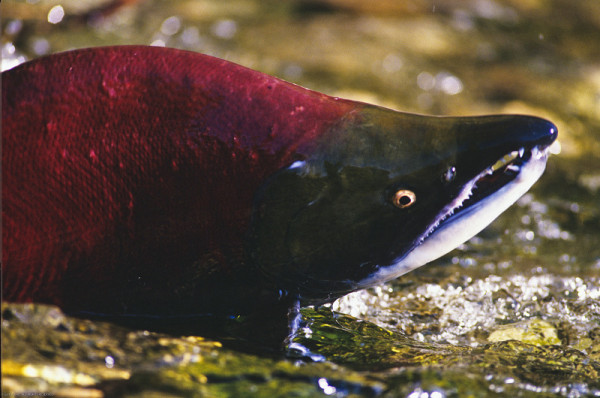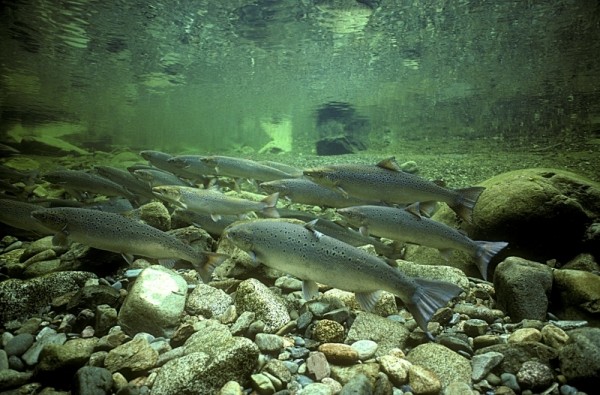It’s Canada Water Week and we’re celebrating our Water Heroes and our Water Hero Species. Time to test your knowledge about one of Canada’s iconic fish: the salmon.
Salmon have a remarkable life cycle that takes them between freshwater and saltwater environments. This makes them a rather unique type of fish that doesn’t neatly fit into being labeled a “freshwater fish” or “saltwater fish”
The Life Stages of Salmon
Salmon begin their lives in freshwater. The adults spawn by laying eggs in gravel beds in freshwater streams and lakes, usually at high latitudes. Once the eggs hatch, the baby salmon, called fry, stay in their natal freshwaters for anywhere from 6 months to 3 years. During this time, they go through various stages of development, transitioning from fry to parr (with camouflage stripes) to smolts when they become ready to migrate to the ocean.
When the smolts reach the ocean, they will spend between 1 to 5 years feeding and maturing in the saltwater habitat. Different species of salmon can have varying ocean phase durations. Atlantic salmon, for example, usually spend 1 to 4 years at sea before returning to their natal freshwaters to spawn. Pacific salmon like coho and sockeye usually have shorter ocean phases of only 1 to 3 years.
Once sexually mature, the adult salmon migrate back to the exact freshwater streams and lakes where they hatched in order to spawn and complete their life cycle. Some species, like steelhead trout, may survive spawning and make the migration multiple times in their lives. But for most Pacific salmon species spawning is followed rapidly by death and the end of their life cycle.
- Eggs laid and hatched in freshwater streams/lakes
- Juveniles mature in freshwater for months to years
- Adults migrate to ocean and feed/mature for 1-5 years
- Adults return to natal freshwaters to spawn then die
This migration between salt and fresh waters makes salmon anadromous fish rather than purely freshwater or saltwater species
The Unique Adaptations of Salmon
This migration between two very different aquatic environments requires some remarkable physiological adaptations in salmon.
As juveniles preparing to migrate to the ocean, smolts go through chemical changes to their body that allow them to osmoregulate and survive in saltwater. Hormones like growth hormone, cortisol, and thyroid hormones increase to boost salinity tolerance and salt secretion capacity.
When salmon return to freshwater as adults, their bodies change in the opposite way to help them get used to living in waters with less salt. They have to swim upstream against strong currents and jump over waterfalls and rapids. It’s a hard journey that makes their bodies weak. Some species even develop humps or hooked jaws to assist in this migration.
Salmon have amazing homing skills; they can find their way back to the water where they were born after years of wandering thousands of miles in the open ocean. It is thought they use their excellent sense of smell for this feat.
The Ecological Importance of Salmon
Salmon are very important to the ecosystems they live in because they move a lot of nutrients and energy from ocean habitats that are high in nutrients to freshwater habitats that are low in nutrients.
When salmon die after spawning, their decomposing carcasses release marine-derived nitrogen and phosphorus. This influx of nutrients provides an important food source for aquatic invertebrates and fertilizes the streams to boost productivity.
Bears, eagles, and other wildlife that prey on salmon also transport these marine nutrients to surrounding riparian forests when they drag salmon bodies inland. Even the salmon that get eaten at sea transport nutrients to their predators.
So in essence, salmon act as a key nutrient link between marine and freshwater realms. Their anadromous life cycle provides a unique conduit for energy and nutrients across these ecosystem boundaries. From an ecological perspective, it makes salmon keystone species in the watersheds where they occur.

Salmon have a really strong sense of smell

Atlantic salmon can smell one drop of scent in an area the equivalent of ten Olympic size pools!
Like WWF-Canada, salmon love both salt water and freshwater

Salmon are considered “anadromous” which means they live in both fresh and salt water. They are born in freshwater where they spend a few months to a few years (depending on the species) before moving out to the ocean. When it’s time to spawn, they head back to freshwater. Very few other fish can survive in such wide ranges of salinity, and would die if they moved between salt and fresh water the way that salmon do. That’s because when saltwater fish are exposed to freshwater, it can cause their cells to burst. And when freshwater fish are exposed to salt water, it can cause their cells to shrivel, due to a process known as osmoregulation. Luckily salmon have some pretty amazing physiological and behavioral adaptations that allow them to survive in both environments.
The Salmon’s Life Mission | Destination WILD
FAQ
Is salmon a freshwater or sea fish?
Are there salmon in the ocean?
Can salmon only live in freshwater?
Is farmed salmon fresh or salt water?
